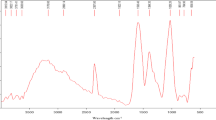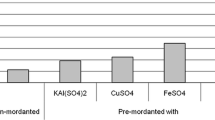Abstract
Textile grade dye from agro-residue, groundnut testa was produced by aqueous extraction. The extracted dye was used for the dyeing of cotton in the presence of alum, ferrous sulfate, and myrobalan. The fastness and functional properties of the dyed fabrics were studied. The results showed that the color fixation of groundnut testa dye on cotton is good, without the aid of mordants; however, the dye produced deeper shades in the presence of mordants. Irrespective of the mordants used, the dyed fabric showed excellent microbial resistance against gram-positive and gram-negative bacteria and ultraviolet protection. Lab to bulk correlation studies of groundnut testa dye was conducted with knitted cotton fabric so that the textile dyeing industry can benefit from this agro- residue natural resource. Color strength (K/S) of the bulk dyed sample is higher than the lab dip with the color difference (dE) found to be higher than the industrial shade approving limit of 1.0. The garment-dyed using tie and dye method exhibited good fastness properties. The printing with the dye extract was also attempted and it showed good printability on cotton. Thus, dyeing and printing using agro-residue of groundnut testa is a source of sustainable and cleaner production of natural dye for the medium and small-scale industries.
Graphic abstract






Similar content being viewed by others
References
Zhu, L., Olsen, C., McHugh, T., Friedman, M., Jaroni, D., Ravishankar, S.: Apple, carrot, and hibiscus edible films containing the plant antimicrobials carvacrol and cinnamaldehyde inactivate Salmonella Newport on organic leafy greens in sealed plastic bags. J. Food Sci. 79(1), 61–66 (2014)
Hazarika, D., Gogoi, N., Jose, S., Das, R., Basu, G.: Exploration of future prospects of Indian pineapple leaf, an agro waste for textile application. J. Clean. Prod. 141, 580–586 (2017)
Jose, S., Samant, L., Bahuguna, A., Pandit, P.: Opportunities in agrowaste utilisation. Opportunities of agro and bio waste in fashion industry. In: Pandit, P., Ahmed, S., Singha, K., Shrivastava, S. (eds.) Recycling from Waste in Fashion and Textiles: A Sustainable and Circular Economic Approach, pp. 33–72. John Wiley & Sons, Inc, Beverly (2020)
Wattanakitjanukul, N., Sukkasem, C., Chiersilp, B., Boonsawang, P.: Use of palm empty fruit bunches for the production of ligninolytic enzymes by Xylaria sp. in solid state fermentation. Waste Biomass Valor. 11, 3953–3964 (2020). https://doi.org/10.1007/s12649-019-00710-0
Young, T., Li, Y., Efthimiou, G.: Olive pomace oil can be used as an alternative carbon source for clavulanic acid production by Streptomyces clavuligerus. Waste Biomass Valor. 11, 3965–3970 (2020). https://doi.org/10.1007/s12649-019-00719-5
Liversidge, R.M., Lloyd, G.J., Wase, D.A.J., Forster, C.F.: Removal of basic blue 41 dye from aqueous solution by linseed cake. Process Biochem. 32, 473–477 (1997)
Marshall, W.E., Champagne, E.T., Evans, W.J.: Use of rice milling by products (hulls and bran) to remove metal ions as aqueous solution. J. Environ. Sci. Health A28, 1977–1992 (1993)
Teli, M.D., Pandit, P., Basak, S.: Coconut shell extract imparting multifunction properties to ligno-cellulosic material. J. Ind. Text. 47, 1261–1290 (2018)
Basak, S., Ali, S.W.: Leveraging flame retardant efficacy of pomegranate rind extract, a novel biomolecule, on ligno-cellulosic materials. Polym. Degrad. Stab. 144, 83–92 (2017)
Pandey, R., Patel, S., Pandit, P., Nachimuthu, S., Jose, S.: Colouration of textiles using roasted peanut skin-an agro processing residue. J. Clean. Prod. 172, 1319–1326 (2018)
Jose, S., Pandit, P., Pandey, R.: Chickpea husk—a potential agro waste for coloration and functional finishing of textiles. Ind. Crops Prod. 142, 111833 (2019)
Sakthi, T.S., Meenakshi, V., Kanchana, S., Vellaikumar, S.: Study on standardisation and quality evaluation of peanut milk by different processing methods. Euro. J. Nutr. Food Saf. 15, 60–72 (2020)
Kassie, M., Shiferaw, B., Muricho, G.: Adoption and impact of improved groundnut varieties on rural poverty: evidence from rural Uganda. Environment for Development Discussion Paper-Resources for the Future (RFF), 10–11 (2010).
Smýkal, P., Vernoud, V., Blair, M.W., Soukup, A., Thompson, R.D.: The role of the testa during development and in establishment of dormancy of the legume seed. Front. Plant Sci. 5, 351 (2014)
Larrauri, M., Zunino, M.P., Zygadlo, J.A., Grosso, N.R., Nepote, V.: Chemical characterization and antioxidant properties of fractions separated from extract of peanut skin derived from different industrial processes. Ind. Crops Prod. 94, 964–971 (2016)
Pandey, R., Pandit, P., Pandey, S., Mishra, S.: Solutions for sustainable fashion and textile industry. Pandit, P., Ahmed, S., Singha, K., Shrivastava, S. (eds.) Recycling from Waste in Fashion and Textiles: A Sustainable and Circular Economic Approach, pp. 33–72. John Wiley & Sons, Inc, Beverly (2020)
Teli, M.D., Pandit, P.: Application of Sterculia Foetida fruit shell waste biomolecules on silk for aesthetic and wellness properties. Fibers Polym. 19, 41–54 (2018)
Sawada, K., Tokino, S., Ueda, M., Wang, X.Y.: Bioscouring of cotton with pectinase enzyme. J. Soc. Dye. Colour. 114, 333–336 (1998)
Tsamo, A.T., Mohammed, H., Mohammed, M., Papoh Ndibewu, P., Dapare Dakora, F.: Seed coat metabolite profiling of cowpea (Vigna unguiculata L. Walp.) accessions from Ghana using UPLC-PDA-QTOF-MS and chemometrics. Nat. Prod. Res. 34, 1158–1162 (2020)
Tapondjou, A.L., Miyamoto, T., Mirjolet, J.-F., Guilbaud, N., Lacaille-Dubois, M.-A.: Pursaethosides A−E, Triterpene Saponins from Entada p ursaetha. J. Nat. Prod. 68, 1185–1190 (2005)
Boruah, G., Phukan, A.R., Kalita, B.B., Pandit, P., Jose, S.: Dyeing of mulberry silk using binary combination of henna leaves and monkey jack bark. J. Nat. Fibers (2019). https://doi.org/10.1080/15440478.2019.1616649
Basu, G., Mishra, L., Jose, S., Samanta, A.K.: Accelerated retting cum softening of coconut fiber. Ind. Crops Prod. 77, 66–73 (2015)
Forfang, K., Zimmermann, B., Kosa, G., Kohler, A., Shapaval, V.: FTIR spectroscopy for evaluation and monitoring of lipid extraction efficiency for oleaginous fungi. PLoS One 12(1), 0170611 (2017)
Bhattacharya, S.D., Shah, A.K.: Metal ion effect on dyeing of wool fabric with catechu. Color. Technol. 116(1), 10–12 (2000)
Uddin, M.G.: Effects of different mordants on silk fabric dyed with onion outer skin extracts. J. Text. 2014, 1–8 (2014). https://doi.org/10.1155/2014/405626
Prabhu, K.H., Bhute, A.S.: Plant based natural dyes and mordants: a review. J. Nat. Prod. Plant Resour. 2(6), 649–664 (2012)
Cadahía, E., Conde, E., García-Vallejo, M.C., Fernández de Simón, B.: High pressure liquid chromatographic analysis of polyphenols in leaves of Eucalyptus camaldulensis, E globulus and E rudis: proanthocyanidins, ellagitannins and flavonol glycosides. Phytochem. Anal. 8, 78–83 (1997)
Conde, E., Cadahia, E., García-Vallejo, M.C.: Low molecular weight polyphenols in leaves of Eucalyptus camaldulensis, E. globulus and E. rudis. Phytochem. Anal. 8, 186–193 (1997)
Jose, S., Gurumallesh Prabu, H., Ammayappan, L.: Eco-friendly dyeing of silk and cotton textiles using combination of three natural colorants. J. Nat. Fibers. 14, 40–49 (2017)
Rajendran, R., Balakumar, C., Kalaivani, J., Sivakumar, R.: Dyeability and antimicrobial properties of cotton fabrics finished with punica granatum extracts. J. Text. Appar. Technol. Manag. (JTATM) 7(2), 1–12 (2011).
Lee, Y.H.: Dyeing, fastness, and deodorizing properties of cotton, silk, and wool fabrics dyed with coffee sludge (Coffea arabica L) extract. J. Appl. Polym. Sci. 103(1), 251–257 (2007)
Sankaran, A., Kamboj,A., Samant, L., Jose, S.: Synthetic and natural UV protective agents for textile finishing. In: Innovative and emerging technologies for textile dyeing and finishing. Scrivener-Wiley Publishers. Accepted (2020).
Shahid, M., Ahmad, A., Yusuf, M., Khan, M.I., Khan, S.A., Manzoor, N., Mohammad, F.: Dyeing, fastness and antimicrobial properties of woolen yarns dyed with gallnut (Quercus infectoria Oliv.) extract. Dyes Pigment. 95(1), 53–61 (2012)
Saravanan, D.: UV protection textile materials. AUTEX Res. J. 7, 53–62 (2007)
Akiyama, H., Fujii, K., Yamasaki, O., Oono, T., Iwatsuki, K.: Antibacterial action of several tannins against Staphylococcus aureus. J. Antimicrob. Chemother. 48, 487–491 (2001)
Jain, P., Nimbrana, S., Kalia, G.: Antimicrobial activity and phytochemical analysis of Eucalyptus tereticornis bark and leaf methanolic extracts. Int. J. Pharmaceutical Sci. Rev. Res. 4, 126–128 (2010)
Godstime, O., Enwa, O., Augustina, J., Christopher, E.: Mechanism of antimicrobial actions of phytochemicals against enteric pathogens—a review. J Pharm ChemBiol Sci. 2, 77–85 (2014)
Soulef, K., Yahia, A.: Antibacterial effects of glycosides extract of Glycyrrhizaglabra L. from the region of Djamaa (South East of Algeria). J. Med. Herbs Ethnomed. 3, 22–25 (2017)
Ammayappan, L., Jose, S.: Functional aspects, ecotesting, and environmental impact of natural dyes. In Handbook of sustainable apparel production, 333, 333–350 (Routledge in association with GSE Research, (2015).
FAOSTAT, F. A. O. Available online: https://www.fao.org/faostat/en/# data. QC. Accessed January 2018 .(2017).
Bathaie, S.Z., Farajzade, A., Hoshyar, R.: A review of the chemistry and uses of crocins and crocetin, the carotenoid natural dyes in saffron, with particular emphasis on applications as colorants including their use as biological stains. Biotech. Histochem. 89, 401–411 (2014)
Kamel, M.M., Helmy, H.M., El-Hawary, N.S.: Some studies on dyeing properties of cotton fabrics with crocus sativus (Saffron flowers) using an ultrasonic method. J. Nat. Fibers 6, 151–170 (2009)
Author information
Authors and Affiliations
Corresponding author
Additional information
Publisher's Note
Springer Nature remains neutral with regard to jurisdictional claims in published maps and institutional affiliations.
Rights and permissions
About this article
Cite this article
Pandit, P., Jose, S. & Pandey, R. Groundnut Testa: An Industrial Agro-Processing Residue for the Coloring and Protective Finishing of Cotton Fabric. Waste Biomass Valor 12, 3383–3394 (2021). https://doi.org/10.1007/s12649-020-01214-y
Received:
Accepted:
Published:
Issue Date:
DOI: https://doi.org/10.1007/s12649-020-01214-y




